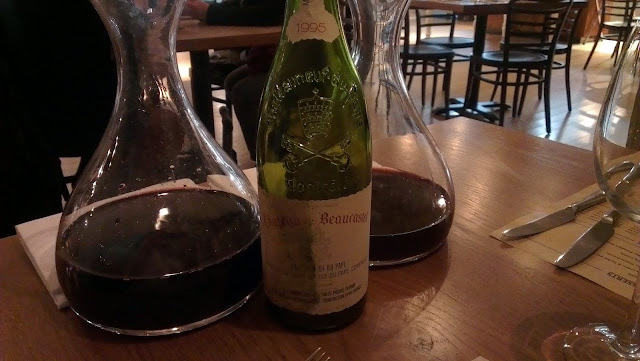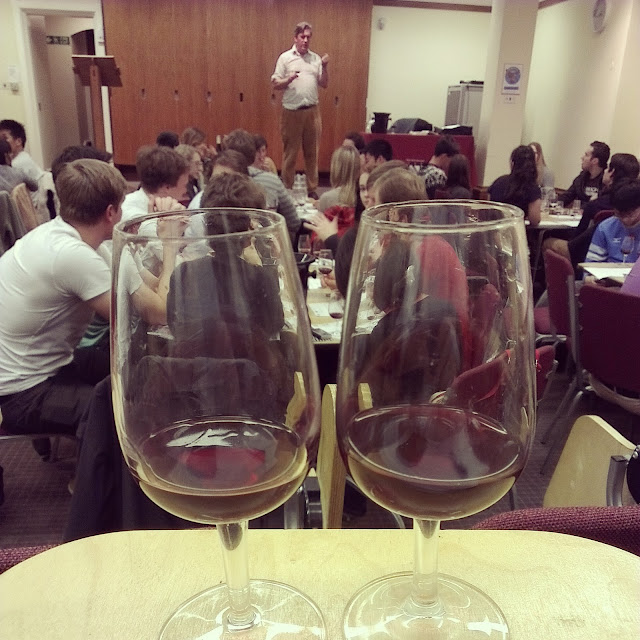
Boukenhoutskloof - The Chocolate Block 2011 (Western Cape,
South Africa)
A blend of two-thirds Syrah, with the remainder made up of Grenache,
Cabernet Sauvignon, Cinsault, and Viognier. Decanted immediately prior to
serving. Clear, with deep purple colouring. Really notably long slow-running tears
inside the glass. Clean nose, very open, with pronounced intensity of sweet
spices and black fruits. Really attractive. Medium-plus acidity, high tannin
and full-bodied on the palate. Pronounced flavour intensity with strong black
fruit characters and a long finish. Excellent quality, excellent value and at
least a decade of cellaring potential ahead of it. 17/20. I’ve never been disappointed
by the wines from Boukenhoutskloof, and this really ought to cost more than the
£20 it retails for!
Chateau de Beaucastel Chateauneuf-du-Pape
1995 (Rhone, France)
Decanted immediately before tasting. Despite having being
stood for >24 hours, there was still a very fine sediment in the wine that
needed additional time to settle out after pouring. Not optimal lighting
conditions, but medium garnet in colour with long tears running down inside the
glass. Clean, open nose with pronounced intensity. Obvious Brett characters
coming across, which obviously will appeal to some and not to others. For me it
is the definition of a good Beaucastel and one of my main reasons for enjoying
their wines! Not the strongest Brett character I have come across in their
wines, but certainly farmyard aromas. Fully developed. The palate was dry with
medium acidity and soft, rounded tannins. Medium-plus body with mature fruit
characters from tertiary bottle development. Medium length finish. I think this is
showing some bottle variation and not quite as good as others I have tasted.
Overall this gave the impression of being at the end of its drinking plateau
and tiring out.
Over the course of 1-2 hours tasting it really began to dry
out. I note Parker’s original tasting note had this down as drinking RP:
2006-2025. While it is still really enjoyable, I probably won’t be keeping my remaining
bottles that long on the basis of this one.
Rosemount Estate - Balmoral Syrah 1999 (McLaren Vale, Australia)
Confusing given Rosemount are based in Hunter Valley, this
wine actually hails from vineyards in the McLaren Vale region. Decanted prior
to drinking, this had thrown fine tannin throughout. Still holding an
inky-opaque colour. Clean, open and pronounced nose still revealing some of the
vanilla character of its very long (18 months+) American oak barrel aging.
Black fruits, logan, white and sweet spices. Complex and really beautiful. One
to just sit and smell and appreciate. The palate is similarly intense, with well balanced tannins set against
a full-bodied, black fruit core. Medium acidity. Good length. Really excellent
and enjoyable. 17+/20.
Over the 2-3 hours this was enjoyed it really started to
lose its fruit and dry out quite quickly, suggesting to me that this is slowly
coming to the end of its drinking plateau. Certainly there is enough fruit
there to keep for another 3-5 years but really I think it is going to start slowly
sliding downhill from here. Penfolds ‘Rewards of Patience’ have this as
drinking through to 2012, hence opening now, although this is perhaps a touch
conservative by a year or two (depending on how you like your wine).
The thing that gets me about these Australian Syrah wines is
how the parabola of their development is rather different to what I’m used to
- compared to, say, a Northern Rhone Syrah. Even at 13-years old this comes
across as more youthful than the equivalent Northern Rhone – less tertiary,
bottle aged character. Perhaps cleaner winemaking, yeast or Brett related? They
mostly stay like this and just dry out whereas I am used to Rhone Syrah wines that
evolve more first. In that way you could say that these wines have a ‘flatter’
drinking plateau whereas the Northern Rhone wines have a much more varied
parabola over their life cycle – they change and evolve through more tastes and
stages.
This was originally judged a 5-star wine in a Decanter
tasting, and agree with every bit of that. Not the best-value given its
number-one premium status in the Rosemount line-up, but really excellent wine.
